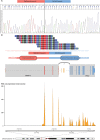Novel transcription-induced fusion RNAs in prostate cancer
- PMID: 28467780
- PMCID: PMC5564755
- DOI: 10.18632/oncotarget.17099
Novel transcription-induced fusion RNAs in prostate cancer
Abstract
Prostate cancer is a clinically and pathologically heterogeneous disease with a broad spectrum of molecular abnormalities in the genome and transcriptome. One key feature is the involvement of chromosomal rearrangements creating fusion genes. Recent RNA-sequencing technology has uncovered that fusions which are not caused by chromosomal rearrangements, but rather meditated at transcription level, are common in both healthy and diseased cells. Such fusion transcripts have been proven highly associated with prostate cancer development and progression. To discover novel fusion transcripts, we analyzed RNA sequencing data from 44 primary prostate tumors and matched benign tissues from The Cancer Genome Atlas. Twenty-one high-confident candidates were significantly enriched in malignant vs. benign samples. Thirteen of the candidates have not previously been described in prostate cancer, and among them, five long intergenic non-coding RNAs are involved as fusion partners. Their expressions were validated in 50 additional prostate tumor samples and seven prostate cancer cell lines. For four fusion transcripts, we found a positive correlation between their expression and the expression of the 3' partner gene. Among these, differential exon usage and qRT-PCR analyses in particular support that SLC45A3-ELK4 is mediated by an RNA polymerase read-through mechanism.
Keywords: RNA sequencing; expression profile; fusion transcript; prostate cancer.
Conflict of interest statement
None.
Figures



Similar articles
-
SLC45A3-ELK4 is a novel and frequent erythroblast transformation-specific fusion transcript in prostate cancer.Cancer Res. 2009 Apr 1;69(7):2734-8. doi: 10.1158/0008-5472.CAN-08-4926. Epub 2009 Mar 17. Cancer Res. 2009. PMID: 19293179 Free PMC article.
-
Androgen regulation of ETS gene fusion transcripts in prostate cancer.Methods Mol Biol. 2011;776:335-48. doi: 10.1007/978-1-61779-243-4_19. Methods Mol Biol. 2011. PMID: 21796535
-
Chimeric transcript generated by cis-splicing of adjacent genes regulates prostate cancer cell proliferation.Cancer Discov. 2012 Jul;2(7):598-607. doi: 10.1158/2159-8290.CD-12-0042. Epub 2012 Jun 19. Cancer Discov. 2012. PMID: 22719019
-
Discovery and Classification of Fusion Transcripts in Prostate Cancer and Normal Prostate Tissue.Am J Pathol. 2015 Jul;185(7):1834-45. doi: 10.1016/j.ajpath.2015.03.008. Epub 2015 May 9. Am J Pathol. 2015. PMID: 25963990 Free PMC article. Review.
-
Signaling networks in TMPRSS2-ERG positive prostate cancers: Do we need a Pied Piper or sharpshooter to deal with "at large" fused oncoprotein.Cell Mol Biol (Noisy-le-grand). 2017 Feb 28;63(2):1-8. doi: 10.14715/cmb/2017.63.2.1. Cell Mol Biol (Noisy-le-grand). 2017. PMID: 28364793 Review.
Cited by
-
Prostatic cancers: understanding their molecular pathology and the 2016 WHO classification.Oncotarget. 2018 Feb 16;9(18):14723-14737. doi: 10.18632/oncotarget.24515. eCollection 2018 Mar 6. Oncotarget. 2018. PMID: 29581876 Free PMC article. Review.
-
Characterization and evaluation of gene fusions as a measure of genetic instability and disease prognosis in prostate cancer.BMC Cancer. 2023 Jun 22;23(1):575. doi: 10.1186/s12885-023-11019-6. BMC Cancer. 2023. PMID: 37349736 Free PMC article.
-
Fusion Transcripts of Adjacent Genes: New Insights into the World of Human Complex Transcripts in Cancer.Int J Mol Sci. 2019 Oct 23;20(21):5252. doi: 10.3390/ijms20215252. Int J Mol Sci. 2019. PMID: 31652751 Free PMC article. Review.
-
Overview of research on fusion genes in prostate cancer.Transl Cancer Res. 2020 Mar;9(3):1998-2011. doi: 10.21037/tcr.2020.01.34. Transl Cancer Res. 2020. PMID: 35117547 Free PMC article. Review.
-
Pan-Cancer Analysis Reveals the Diverse Landscape of Novel Sense and Antisense Fusion Transcripts.Mol Ther Nucleic Acids. 2020 Mar 6;19:1379-1398. doi: 10.1016/j.omtn.2020.01.023. Epub 2020 Jan 29. Mol Ther Nucleic Acids. 2020. PMID: 32160708 Free PMC article.
References
-
- Jemal A, Bray F, Center MM, Ferlay J, Ward E, Forman D. Global cancer statistics. CA Cancer J Clin. 2011;61:69–90. - PubMed
-
- Tomlins SA, Rhodes DR, Perner S, Dhanasekaran SM, Mehra R, Sun XW, Varambally S, Cao X, Tchinda J, Kuefer R, Lee C, Montie JE, Shah RB, et al. Recurrent fusion of TMPRSS2 and ETS transcription factor genes in prostate cancer. Science. 2005;310:644–648. - PubMed
MeSH terms
Substances
LinkOut - more resources
Full Text Sources
Other Literature Sources
Medical

